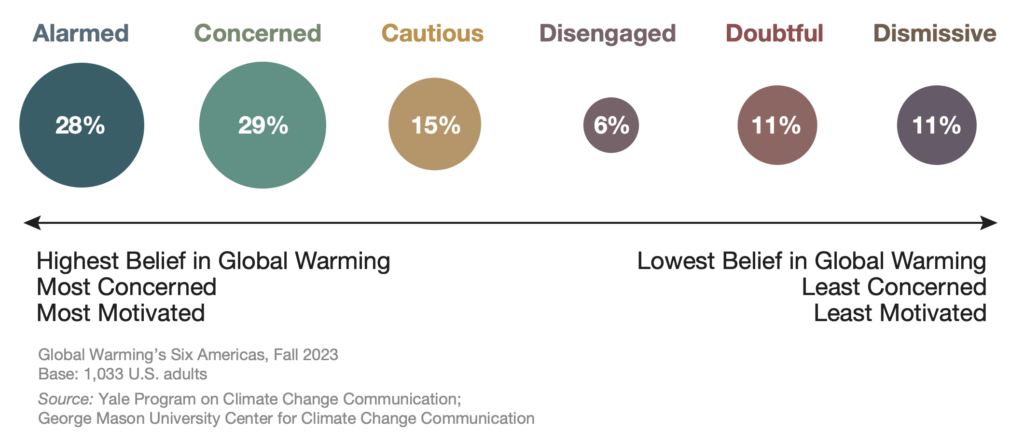Climate Note · Dec 14, 2023
Global Warming’s Six Americas, Fall 2023
By Anthony Leiserowitz, Edward Maibach, Seth Rosenthal, John Kotcher, Emily Goddard, Jennifer Carman, Marija Verner, Matthew Ballew, Jennifer Marlon, Sanguk Lee, Teresa Myers, Matthew Goldberg, Nicholas Badullovich and Kathryn Thier
Filed under: Audiences and Beliefs & Attitudes
In 2009, we identified Global Warming’s Six Americas – the Alarmed, Concerned, Cautious, Disengaged, Doubtful, and Dismissive – which represent distinct climate opinion audiences within the American public. The Alarmed are the most worried about global warming and the most likely to support and engage in pro-climate action. The Concerned are also worried about global warming, but they view it as a less serious threat and are less motivated to act. The Cautious are uncertain about global warming and are not very worried about it, so they are less motivated to take action. The Disengaged are disconnected from the issue and rarely hear about it. The Doubtful question whether global warming is happening or human-caused, and are among the least worried about it and motivated to act. The Dismissive reject the idea that global warming is happening and human-caused and do not believe it is a threat, so they are the most likely to oppose climate action.
In 2018, we created and published the Six Americas Survey (SASSY), a short, four-question online questionnaire that can be used to identify which Six Americas segment people belong to. Using SASSY as part of our Fall 2023 Climate Change in the American Mind nationally representative survey, we find that 28% of Americans are Alarmed and that the Alarmed outnumber the Dismissive (11%) by a ratio of more than 2 to 1. Further, when the Alarmed and Concerned are grouped together, a majority of Americans (56%) fall into one of these audiences.Percentage points are rounded to the nearest whole number for tabulation purposes and summed categories (e.g., “Alarmed” + “Concerned”) are rounded after sums are calculated (e.g., 27.6% + 28.6% = 56.2%, which after rounding would appear in this report as 28% + 29% = 56%). Overall, Americans are more than twice as likely to be Alarmed or Concerned than they are Doubtful or Dismissive (23%). Additionally, the percentage of Republicans who are either Alarmed or Concerned has increased by 6 percentage points over the past year (from 22% to 28%), while the already high percentage of Democrats who are Alarmed or Concerned has remained the same (82%; refer to Table 2 in the data tables).
The Six Americas Over the Last Decade
Over the past ten years, the Alarmed have grown more than any other audience, nearly doubling in size from 15% in 2013 to 28% in 2023 (+13 percentage points). Conversely, the Cautious have decreased in size the most during that time, from 26% in 2013 to 15% in 2023 (-11 percentage points). Additionally, the percentage of Americans who are either Alarmed or Concerned has increased from 40% in 2013 to 56% in 2023 (+16 percentage points). The Disengaged and Dismissive audiences have remained relatively similar in size over the last decade.
Communication Opportunities
More Americans have become worried about global warming over the last 10 years, and majorities are also worried about various climate impacts and extreme weather events harming their local community. Worry about extreme heat has especially increased over the past five years. Additionally, the public increasingly understands that global warming is affecting the weather. With record-breaking temperatures and other extreme weather events on the rise, it is important to continue educating the public to understand that climate change impacts are happening here and now and will increasingly harm American communities if we don’t take action to greatly limit the pollution that causes global warming.
Americans want more climate solutions and policies. Our research has shown that most registered voters support numerous policies to reduce the pollution that causes global warming and prefer to vote for a candidate who supports action on global warming.
Methods
Data are from the biannual Climate Change in the American Mind survey, a nationally-representative survey of public opinion on climate change in the United States conducted by the Yale Program on Climate Change Communication and the George Mason University Center for Climate Change Communication. Surveys were conducted from October 20 – 26, 2023 using the Ipsos KnowledgePanel®, a representative online panel of U.S. adults (18+). Respondents self-administered the questionnaires online in a web-based environment.
The average margin of error for each wave is +/- 3 percentage points at the 95% confidence level. Results are adjusted on a number of key demographic categories to align with U.S. Census parameters. Percentage points are rounded to the nearest whole number for tabulation purposes and summed categories (e.g., “Alarmed” + “Concerned”) are rounded after sums are calculated (e.g., 27.6% + 28.6% = 56.2%, which after rounding would appear in this report as 28% + 29% = 56%). Percentages in a given chart may total slightly higher or lower than 100%.
References to Republicans and Democrats include respondents who initially identify as either a Republican or Democrat, as well as those who do not initially identify as a Republican or Democrat but who say they are closer to one of those parties (i.e., leaners) in a follow-up question.
The data tables used in this report can be found here.
Resources and Data
The Six Americas Survey (SASSY) is a short, four-question online questionnaire that identifies which audience people belong to (Chryst et al., 2018). Results also show how respondents’ views about global warming compare with the views of the U.S. population as a whole.
The SASSY Group tool allows users to upload their own data (e.g., from one’s own survey, a class, members of an organization, etc.). This tool determines the Six Americas segment for each person in the dataset and provides a downloadable spreadsheet and summary graphics.

